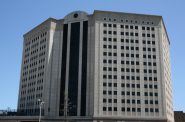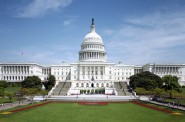Proposal Limits Schools’ Energy Efficiency
186 districts have funded money-saving projects since 2009; legislation would restrict this.
A provision included in the proposed state budget would restrict school districts from exceeding their state-imposed budget caps in order to fund money-saving energy efficiency improvements.
Currently, the state sets a limit on how much money each school district can spend through the combination of state aid and property taxes, although voters in a district can override the spending limit by approving a referendum. The hurdle is lower when the district wants to temporarily lift the district’s budget cap to allow for spending on energy efficiency projects that save the school district money: only the approval of the school board is needed. The school board must specify the payback period after which the district is expected to recoup its investment in the upgraded facilities.
Exceeding the budget caps set by the state to fund energy efficiency projects has two advantages for school districts: It enables them to raise the resources needed to make improvements to school buildings, and it saves school districts money in the long run. School districts may only exceed their revenue limits for efficiency projects that reduce energy or operational costs.
Since 2009, 186 districts have used this ability to temporarily exceed their budget caps, funding 501 different energy efficiency projects like replacing boilers, improving insulation, and upgrading windows. Those projects represent $1.3 billion in energy-saving investments that have resulted in lower costs for school districts. The map below shows districts that have used this exemption to reduce costs.
Some lawmakers want to eliminate or restrict the ability of school districts to exceed their revenue limits to fund energy efficiency projects. The state’s two-year budget – which was supposed to have been settled by the end of June – is still in flux, but most of the competing proposals that lawmakers are currently considering would make it harder for districts to save money by improving their energy efficiency. The education budget proposed by Governor Walker would eliminate the ability of school boards to approve an increase in the budget caps for energy efficiency projects, and the Senate version of the budget would put a two-year moratorium on these projects. It’s not clear whether the Assembly version of the budget includes any restrictions on energy efficiency exemptions.
Under these proposals, districts would only be able to raise additional resources for energy efficiency projects by holding a referendum, and by bearing part or all of the costs of holding the election. The goal of implementing energy efficiency projects is to save districts money; forcing districts to spend additional money on holding elections in order to save money would increase the length of the payback period for the energy efficiency projects. Also, many of the energy efficiency projects are small, and the costs of holding a referendum may not be proportionate to the size of the project. Examples of small projects that may not be cost-efficient if the district has to bear the cost of the election include:
- $8,000 in Friess Lake to replace lightbulbs. The district anticipated recouping its costs within three years due to lower energy costs;
- $11,000 in Riverdale to install lights that turn off when no one is around; and
- $14,000 in Eleva-Strum to replace the 30-year old HVAC system in the technology education area.
The energy efficiency exemption allows districts to make investments that lower costs, thereby providing the same services to students for less money. Eliminating or restricting the energy efficiency exemption will increase the amount of money it costs to educate Wisconsin schoolchildren. Lawmakers who want school districts to curtail their spending should refuse to go along with ending the exemption for energy efficiency projects.
Wisconsin Budget
-
Charting The Racial Disparities In State’s Prisons
 Nov 28th, 2021 by Tamarine Cornelius
Nov 28th, 2021 by Tamarine Cornelius
-
State’s $1 Billion Tax Cut Leaves Out 49% of Taxpayers
 Sep 21st, 2021 by Tamarine Cornelius
Sep 21st, 2021 by Tamarine Cornelius
-
TANF Program Serves a Fraction of Poor Families
 Aug 30th, 2021 by Jon Peacock
Aug 30th, 2021 by Jon Peacock






















Everyone knows that this is simply a creative way to get around state-imposed revenue (tax) caps. When my 30-year old furnace fails in my home, I don’t get to tap into my ‘energy efficiency exemption’ and pass a referendum… the cash comes out of the same source as any other expense. A school needs to budget for routine maintenance and replacement of depreciating capital items using ‘expected lifetimes.’ If they fail to do so, it’s not responsible budgeting. Hopefully this loophole can be closed.
Everyone knows that … a school (board) needs to budget for routine maintenance and replacement of depreciating capital items using ‘expected lifetimes.’ The right-wing state government is making yet another move to usurp local control.
This scam is about to end. Unfortunately the many fraudsters involved were not stopped sooner, nor held accountable to the law. It took quite awhile but we are very close to ending this.
I hope all the abusers of this program understand that their illicit misuse of the Energy Efficiency Program has caused it to be taken away from other School Districts that would have used it morally and ethically to help their student’s education. While I doubt they do, I am quite confident they are very proud of themselves for ruining a program that was meant to be a good thing for our educational system if it were used honestly.
From my understanding the Energy “Deficiency” Program will end at the end of 2017. School Districts will be allowed to submit Resolutions to exceed the Revenue Caps up until Dec. 31, 2017 and then this hoax of a program is hopefully over for good. The true costs, thus far, to the WI Taxpayer is now up to $1,173,927,183.41(Yes over a Billion dollars) and the taxpayers had no right of referendum vote on this. Since schools now have over 3 months to continue this program that lacks any accountability or requirement for proof whatsoever as to the “non-utility” cost savings being alleged by the vast majority of schools for their justification, you will be seeing this cost to the taxpayers skyrocket until the end of the year. My local school district did $8,000,000 in projects of which only $800,000 was in actual “energy savings”. The rest ($7,200,000) was completely fictitious numbers made up under the guise of such things as “operational savings”, “maintenance savings”, “Cost Savings” “Cost Avoidance” etc, etc, etc and no requirement of proof was needed.
Latest Update: The true cost to WI taxpayers has now reached $1,201,671,733.02 without right of referendum vote.
The cost to the taxpayers is now up to $1,364,436,817.41. This should be the end of it as Governor Walker did end it until the year 3018. Fortunately Schools will no longer be allowed to continue with this program and create new shams. Unfortunately those that have been shammed will still be held liable for the trickery played by so many schools on this program. And to think some legislators already want this program reinstated even though the taxpayers have already been hit for $1,364,436,817.41 of projects that are required by law for the savings to equal or exceed the costs of the projects…..Or in other words; the projects were supposed to pay for themselves.